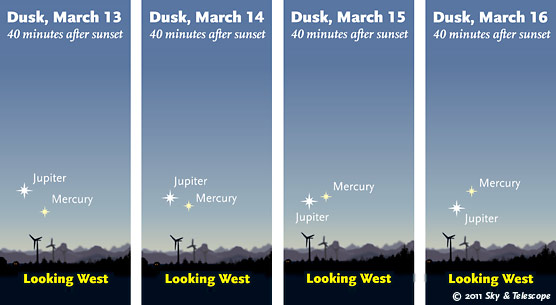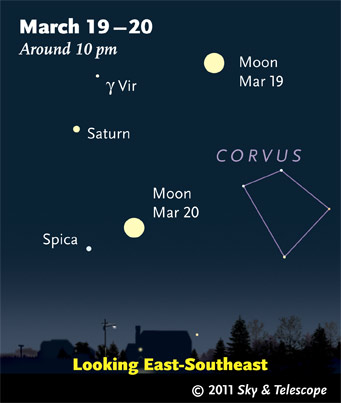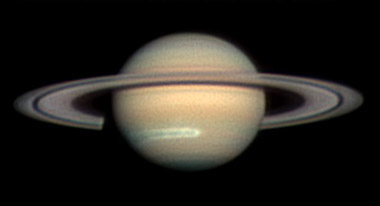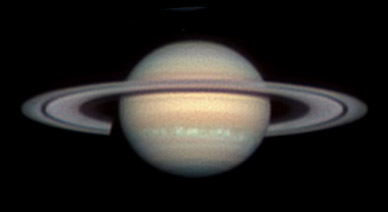Friday, March 11
Saturday, March 12

Find a spot with a clear, open view low to the west, and you can watch Mercury passing Jupiter in twilight from March 13 to 16. Click on image for an animation!
Feel free to use these illustrations anywhere — just credit Sky & Telescope magazine and include a link to SkyandTelescope.com.
Credit: Sky & Telescope magazine
Sunday, March 13
Monday, March 14
And, you probably know that if you follow the curve of the Dipper's handle out and around by a little more than a Dipper length, you'll arc to Arcturus, now rising in the east.
But did you know that if you follow the Pointers backward the opposite way, you'll leap to Leo?
Draw a line diagonally across the Dipper's bowl from where the handle is attached, continue on, and you'll go to Gemini.
And look at the two stars forming the open top of the Dipper's bowl. Follow this line past the bowl's lip far across the sky, and you crash into Capella.
Tuesday, March 15
Wednesday, March 16
Thursday, March 17
Friday, March 18

The big bright Moon guides the way to Saturn and its springtime surroundings.
Alan MacRobert
Saturday, March 19
Sky at a Glance is now an iPhone app! Put S&T SkyWeek on your iPhone, iPad, or iPod Touch and get the above listings anytime, anywhere — with interactive sky maps! Tap a button to see the scene described, customized for your location worldwide. From there you can scroll the view all around the sky, zoom in or out, change to any time or date, and turn on animation.
Go to Apple's iTunes store from your device to get S&T SkyWeek.
Want to become a better amateur astronomer? Learn your way around the constellations. They're the key to locating everything fainter and deeper to hunt with binoculars or a telescope.
For an easy-to-use constellation guide covering the whole evening sky, use the big monthly map in the center of each issue of Sky & Telescope, the essential magazine of astronomy. Or download our free Getting Started in Astronomy booklet (which only has bimonthly maps).

The Pocket Sky Atlas plots 30,796 stars to magnitude 7.6 — which may sound like a lot, but that's less than one star in an entire telescopic field of view, on average. By comparison, Sky Atlas 2000.0 plots 81,312 stars to magnitude 8.5, typically one or two stars per telescopic field. Both atlases include many hundreds of deep-sky targets — galaxies, star clusters, and nebulae — to hunt among the stars.
Sky & Telescope
Once you get a telescope, to put it to good use you must have a detailed, large-scale sky atlas (set of charts). The standards are the Pocket Sky Atlas, which shows stars to magnitude 7.6; the larger Sky Atlas 2000.0 (stars to magnitude 8.5); and the even larger and deeper Uranometria 2000.0 (stars to magnitude 9.75). And read how to use sky charts effectively.
You'll also want a good deep-sky guidebook, such as Sky Atlas 2000.0 Companion by Strong and Sinnott, or the more detailed and descriptive Night Sky Observer's Guide by Kepple and Sanner, or the classic if dated Burnham's Celestial Handbook.
Can a computerized telescope take their place? I don't think so — not for beginners, anyway, and especially not on mounts that are less than top-quality mechanically. As Terence Dickinson and Alan Dyer say in their Backyard Astronomer's Guide, "A full appreciation of the universe cannot come without developing the skills to find things in the sky and understanding how the sky works. This knowledge comes only by spending time under the stars with star maps in hand."
This Week's Planet Roundup

Saturn's dispersing white spot "looks like a comet," wrote Christopher Go. As of March 2nd its head had moved far around the planet to about System III longitude 120°. This image (taken February 6th) exaggerates its contrast. South is up. Click for animation of several images spanning 33 minutes of Saturn's rotation. And see an even more awesome Cassini image.
Mercury and Jupiter (magnitudes –1 and –2.1, respectively) pass each other low in the western twilight this week, as shown at the top of this page. You'll need a good open view low toward the western horizon. As twilight fades, you'll probably pick up brighter Jupiter first. Use it to locate Mercury. They appear closest together on Monday and Tuesday, March 14th and 15th, 2° apart. That's about the width of your thumb at arm's length.
By a remarkable coincidence, both planets pass through perihelion this week (closest to the Sun in their orbits). Mercury has a perihelion every 88 days, but Jupiter has one only every 12 years.
Venus (magnitude –4.0, in Capricornus) shines low in the southeast during dawn.
Mars is out of sight behind the glare of the Sun.

The other side of Saturn, imaged by Go on February 11th. The dark, reddish South Equatorial Belt can be seen just south of the ring. South is up.
Saturn (magnitude +0.4, in Virgo) rises around 8 or 9 p.m., but it's best seen in a telescope much later in the night when it gains high altitude. It's highest in the south around 2 or 3 a.m. daylight saving time. Spica, slightly fainter, shines about 10° below Saturn all evening and past midnight. About half as far above or upper right of Saturn is dimmer Gamma Virginis (Porrima).
In a telescope, Saturn's months-old white spot has spread into a streak far around the planet, as seen here. Saturn's rings are 9° from edge on. See how many of Saturn's satellites you can identify in your scope using our Saturn's Moons tracker.
Uranus and Neptune are hidden in the glare of the Sun.
All descriptions that relate to your horizon — including the words up, down, right, and left — are written for the world's mid-northern latitudes. Descriptions that also depend on longitude (mainly Moon positions) are for North America. Eastern Standard Time (EST) equals Universal Time (also known as UT, UTC, or GMT) minus 5 hours. Eastern Daylight Time (EDT) is UT minus 4 hours.
To be sure to get the current Sky at a Glance, bookmark this URL:
http://SkyandTelescope.com/observing/ataglance?1=1
If pictures fail to load, refresh the page. If they still fail to load, change the 1 at the end of the URL to any other character and try again.
 0
0
Comments
You must be logged in to post a comment.